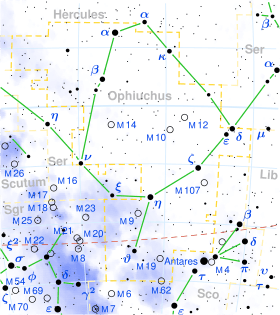Omicron Serpentis

| |
| Observation data Epoch J2000 Equinox J2000 | |
|---|---|
| Constellation | Serpens |
| Right ascension | 17h 41m 24.87286s [1] |
| Declination | −12° 52′ 31.1086″ [1] |
| Apparent magnitude (V) | 4.24 [2] |
| Characteristics | |
| Spectral type | A2Va [3] |
| B−V color index | +0.09 [2] |
| Variable type | δ Sct[4] |
| Astrometry | |
| Radial velocity (Rv) | -30.20[5] km/s |
| Proper motion (μ) | RA: -72.90[1] mas/yr Dec.: -55.55[1] mas/yr |
| Parallax (π) | 18.83 ± 0.25[1] mas |
| Distance | 173 ± 2 ly (53.1 ± 0.7 pc) |
| Absolute magnitude (MV) | 0.62 [6] |
| Other designations | |
| Database references | |
| SIMBAD | data |
Omicron Serpentis (ο Ser, ο Serpentis) is a star in the constellation Serpens.
Omicron Serpentis is a white A-type main sequence dwarf with an apparent magnitude of +4.24. It is approximately 173 light years from Earth.[1] It is classified as a Delta Scuti type variable star and its apparent magnitude varies by 0.01 with a period of 76 minutes.[7]
References
- 1 2 3 4 5 6 van Leeuwen, F. (2007). "Validation of the new Hipparcos reduction". Astronomy and Astrophysics. 474 (2): 653–664. arXiv:0708.1752
 . Bibcode:2007A&A...474..653V. doi:10.1051/0004-6361:20078357. Vizier catalog entry
. Bibcode:2007A&A...474..653V. doi:10.1051/0004-6361:20078357. Vizier catalog entry - 1 2 3 "Omicron Serpentis". SIMBAD Astronomical Database. Retrieved 2015-10-17.
- ↑ Houk, N. (1988), Michigan catalogue of two-dimensional spectral types for the HD stars, 4, Ann Arbor: Dept. of Astronomy, University of Michigan, Bibcode:1988MSS...C04....0H
- ↑ Samus, N. N.; Durlevich, O. V.; et al. (2009). "VizieR Online Data Catalog: General Catalogue of Variable Stars (Samus+ 2007-2013)". VizieR On-line Data Catalog: B/gcvs. Originally published in: 2009yCat....102025S. 1. Bibcode:2009yCat....102025S.
- ↑ Gontcharov, G. A. (November 2006). "Pulkovo Compilation of Radial Velocities for 35 495 Hipparcos stars in a common system". Astronomy Letters. 32 (11): 759–771. Bibcode:2006AstL...32..759G. doi:10.1134/S1063773706110065.
- ↑ Absolute magnitude calculated as , where is the star's absolute magnitude, is the star's apparent magnitude, and is the star's measured parallax in arcseconds.
- ↑ Chang, S.-W.; Protopapas, P.; Kim, D.-W.; Byun, Y.-I. (2013). "Statistical Properties of Galactic δ Scuti Stars: Revisited". The Astronomical Journal. 145 (5). arXiv:1303.1031
 . Bibcode:2013AJ....145..132C. doi:10.1088/0004-6256/145/5/132. Vizier catalog entry
. Bibcode:2013AJ....145..132C. doi:10.1088/0004-6256/145/5/132. Vizier catalog entry
This article is issued from Wikipedia - version of the 4/26/2016. The text is available under the Creative Commons Attribution/Share Alike but additional terms may apply for the media files.